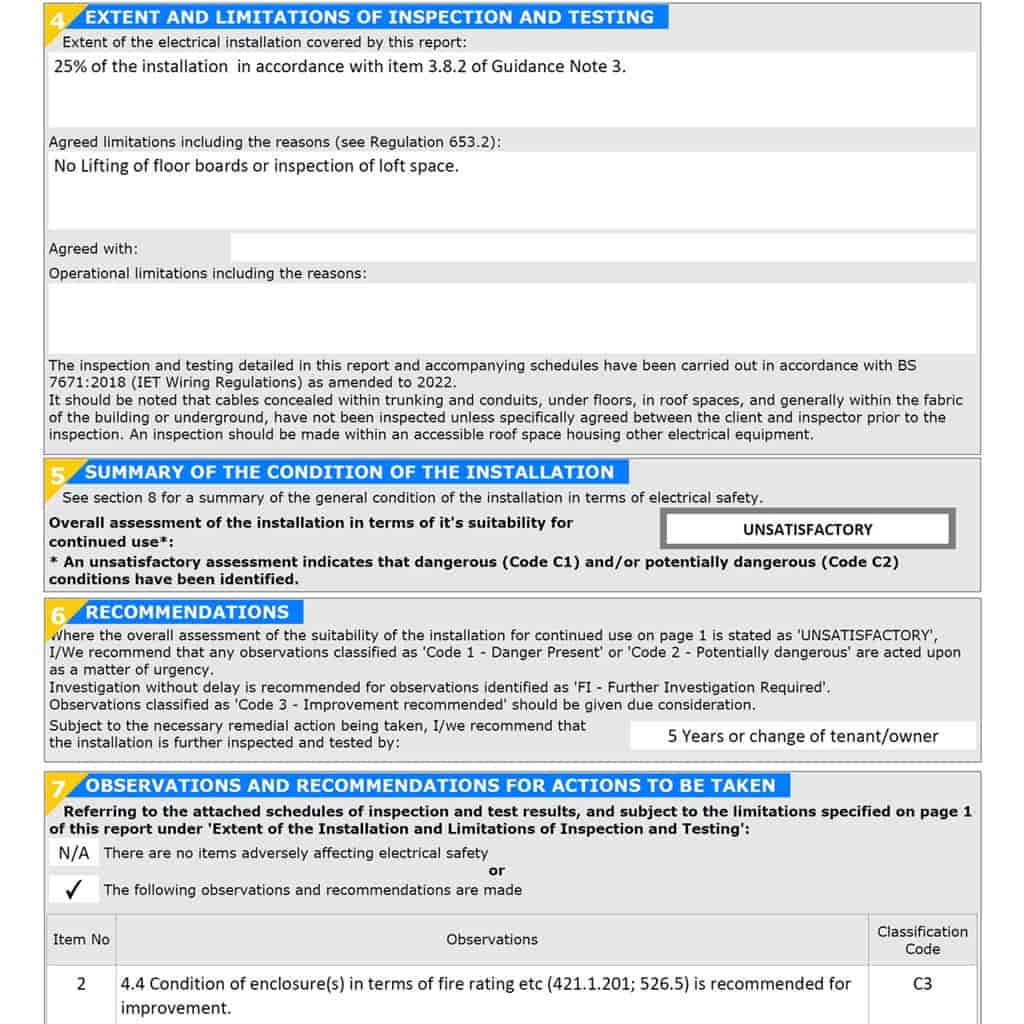An Electrical Installation Condition Report (EICR) measures the safety and condition of electrical systems within a property, ensuring they comply with the necessary standards for occupancy or rental. However, certain limitations can influence the EICR inspection.
This page forms part of our guide to EICR fault codes and follows on from the recent page on EICR codes that recommend further investigation.
What are limitations on an EICR?
Limitations on an EICR refer to specific conditions or restrictions that prevent the electrician from fully testing or evaluating certain parts of the electrical installation. These limitations must be clearly stated in the report to ensure transparency about what was and wasn’t inspected.
Examples of limitations in an EICR
Understanding common “EICR limitations” helps property owners and landlords understand the constraints that might impact the inspection. Examples of agreed and operational EICR limitations could include:
- Inaccessible areas: Parts of the installation that are blocked or not easily reachable, such as behind heavy furniture, inside locked rooms, attic spaces, under floors or within confined spaces.
- Concealed wiring: Wiring hidden within walls, floors, or ceilings that cannot be visually inspected without intrusive methods.
- Limited documentation: Lack of available drawings that detail the existing electrical installation, making it difficult to verify certain aspects or cable routes.
- Live testing: Safety concerns may prevent thorough testing of live circuits, especially in occupied properties like hospitals, vets or doctor surgeries were turning off power is not feasible.
Understanding limitations is important
Recognising the limitations of an EICR is crucial for property owners and landlords because it sets realistic expectations about the extent of the inspection. It also highlights areas that may require further investigation or consideration during future maintenance or upgrades.
Effectively dealing with limitations involves being proactive and ensuring that all possible measures are taken to facilitate a thorough inspection. This might include arranging for access to locked areas, moving heavy furniture, or scheduling the inspection at a time when more invasive methods can be used without causing disruption.
By addressing these limitations, you can ensure a more accurate assessment of your electrical installation.
How limitations affect the EICR outcome
Limitations can impact the overall outcome of the EICR. If significant areas of the installation cannot be inspected, the report’s value is reduced. This means that while the accessible parts of the installation might be safe, un-inspected areas could potentially harbor undiscovered issues.
Addressing limitations in an EICR
Addressing EICR limitations involves:
- Scheduling further inspections: For areas that were inaccessible during the initial EICR, scheduling follow-up inspections when those areas can be accessed.
- Providing documentation: Ensuring that all relevant electrical documentation and drawings are available for the electrician.
- Intrusive inspections: In cases where it is safe and practical, arranging for more intrusive inspections to thoroughly check concealed wiring and other hidden elements.
Benefits of addressing limitations
Proactively addressing the limitations of an EICR will increase the safety and reliability of the electrical installation. It ensures a full understanding of the installation’s condition, helping to prevent potential issues and ensuring compliance with safety standards.

Legal obligations for landlords regarding EICR limitations
Landlords have a legal obligation to ensure the safety of their tenants. Addressing the limitations highlighted in an EICR report is part of this responsibility. Failure to do so can result in penalties and prevent the property from being rented out.
Conclusion
Often called ‘operational limitations’ or ‘agreed limitations’, limitations on an EICR refer to conditions that prevent a full assessment, such as inaccessible areas or concealed wiring. Recognising these limitations is crucial as they impact the inspection’s scope and depth. Addressing limitations helps ensure a full assessment of your electrical installation.
See our main EICR page to organise EICR testing in Edinburgh for landlords and property owners.
Please feel free to contact us if you have had a test conducted recently by another company and would like our opinion or simply to ask us a question.
We hope you are finding our EICR articles useful.
All the best
Mark and the IES team.


Please let me know if an EICR is NOT SIGNED by Electrician is their certificate valid. If the electrician put limited access when he had full access but refused to test the Electric of 2 cables crimped together going in to the landlords unregistered meter is the certificate valid. The check meter unregistered on the landlords wall has 2 cables C and D from the tenants house crimped together and the box is chewed wires and damp ingress and a Hazzard, the electricians said its fine you will only get a bolt if you touch it. But wouldn’t test the electrics despite access on the outside wall despite opening the cabinet and looking at the electrics. The cables from the tenants house also go into the landlords workshop. including armoured cable going into what we though was an official meter with an MPAN number now i question was this a real certificate. NOT signed to me is an alarm bell
Thank you for reaching out with your concerns. We understand that situations like this can be worrying, and we want to clarify that we did not carry out the EICR in question. However, we can still offer some general advice.
For an EICR to be valid, it should indeed be signed by the electrician who conducted the inspection. If the electrician refused to test certain areas despite having full access, that could be a potential issue. In any case, it’s important that the EICR reflects a thorough and accurate assessment of the electrical installation.
Given the specific concerns about crimped cables, damp ingress, and other possible hazards you’ve mentioned, we recommend seeking a second opinion from another qualified electrician to ensure that the installation is safe and compliant with regulations.
If you’d like, we’d be happy to advise you on how to proceed, or if you need assistance in arranging an inspection.
We hope this helps, and please don’t hesitate to reach out if you have any further questions.ax